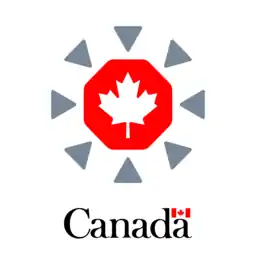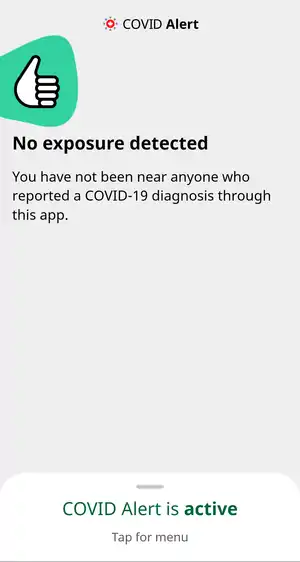COVID Alert
COVID Alert (French: Alerte COVID[4]) is the Exposure Notification (EN) service app for the country of Canada. It launched in the province of Ontario on July 31, 2020, and become available in nearly all Canadian provinces by October of that year, excluding Alberta (which is continuing to use its existing, BlueTrace-based app instead), and British Columbia.
 | |
Screenshot  | |
| Developer(s) | |
|---|---|
| Initial release | July 31, 2020 |
| Repository | https://github.com/cds-snc/covid-alert-app |
| Operating system | Android, iOS |
| Size | |
| Standard(s) | Exposure Notification[3] |
| Available in | English, French |
| Type | Digital contact tracing |
| Website | Official website |
As with all other implementations of EN, it uses Bluetooth to broadcast and receive randomly-generated IDs to and from the smartphones of other COVID Alert users within the user's vicinity. If a user later tests positive for COVID-19, they can choose to anonymously flag their IDs within a specific timeframe, allowing others to be notified of a possible exposure.[5]
In September 2020, it was reported that the app had at least 3 million users.[6]
History
On June 18, 2020, Prime Minister Justin Trudeau announced that the federal government would partner with enterprise technology company BlackBerry Limited and ecommerce firm Shopify to develop a voluntary, anonymous contact tracing app to manage the COVID-19 pandemic in Canada.[7] The app was developed by the COVID Shield project, an open source reference implementation backed by volunteer employees of Shopify and the Linux Foundation Public Health initiative, and the Canadian Digital Service, with BlackBerry providing security guidance.[8][9]
On July 23, after a delay from an originally-anticipated soft launch in early-July, Canadian Digital Service announced that it would begin beta testing the COVID Alert app in Ontario.[10]
The app officially launched on July 31 in Ontario; Trudeau stated that the app does not replace manual contact tracing, and that other Canadian provinces would adopt the app "soon".[5]
Adoption
By October 2020, all but two Canadian provinces had adopted COVID Alert with full support for reporting.[11] In unsupported regions, the app can be used to receive notifications of possible COVID-19 exposures involving users who reside in a supported region, but users cannot send reports of their own positive infections.[12]
| Province/Territory | Reporting | Start date | Notes |
|---|---|---|---|
| No | See: ABTraceTogether | ||
| No | |||
| Yes | |||
| Yes | |||
| Yes | |||
| Yes | |||
| Yes | 2020-07-31 | ||
| Yes | |||
| Yes | |||
| Yes | |||
| Yes | |||
| No | |||
| No | |||
Alberta
Alberta had already deployed its own encounter logging app, ABTraceTogether (which is based upon Singapore's TraceTogether app and the BlueTrace protocol), in May 2020, describing it as the first of its kind in North America.[13] In comparison to COVID Alert, it provides contact tracing details directly to Alberta Health Services, but cannot run in the background on iPhone due to iOS limitations (requiring it to be open and in the foreground in order to operate correctly).[14][15] The app has faced criticism over this limitation and possible privacy concerns, with calls for the provincial government to migrate to COVID Alert instead to assure more efficient operation on iOS, and interoperability with other provinces.[16][17]
In August 2020, the Alberta government accused federal officials of "interfering" with its ability to work with Apple on releasing updates to ABTraceTogether to address these shortcomings. Later in the month, the province announced plans to "migrate" ABTraceTogether users to COVID Alert,[18][19] but this did not actually occur.[11] In October 2020, members of the United Conservative Party (UCP) were heard ridiculing COVID Alert as "Trudeau's app" during Question Period, prompting Mayor of Calgary Naheed Nenshi to call for the province to adopt the app, and warn against the "politicization of public health".[20][21] In an October 30 radio interview, Prime Minister Trudeau called upon the UCP government of Premier Jason Kenney to adopt the app, and suggested that Alberta residents download it so that they could still use it with out-of-province users, and be ready in the event that it were to be adopted.[22]
On November 6, Premier Kenney stated that Alberta would not adopt COVID Alert, stating that the province would no longer be able to operate ABTraceTogether if it did, and that the latter was "from our view, simply a better and more effective public health tool".[23]
British Columbia
British Columbia is not using COVID Alert, with provincial health officer Bonnie Henry stating that the app would require "modifications" in order to be used in the province, citing issues such as how long it stores contact tracing data. Henry suggested an approach based on using check-ins to identify exposures by locations and timeframes.[24]
References
- "COVID Alert - Apps on Google Play". play.google.com. Retrieved 2020-08-01.
- "COVID Alert". App Store. Retrieved 2020-08-01.
- Miller, Chance (2020-07-31). "COVID Alert app, built with Apple and Google Exposure Notification API, now available in Canada". 9to5Mac. Retrieved 2020-08-01.
- "Téléchargez Alerte COVID dès maintenant". aem. 2020-07-31. Retrieved 2020-08-01.
- "Canada launches COVID-19 tracking app — but only in Ontario". Global News. Retrieved 2021-01-13.
- "COVID Alert app nears 3 million users, but only 514 positive test reports". CTV News. 2020-09-29. Retrieved 2021-01-13.
- "Shopify, BlackBerry working with feds on COVID-19 tracing app". BNN Bloomberg. 2020-06-18. Retrieved 2021-01-13.
- "Federally-backed COVID alert app now available in Ontario". CTV News Ottawa. 2020-07-31. Retrieved 2020-08-02.
- "Linux Foundation announces open source exposure notification apps initiative to combat COVID-19". TechRepublic. Retrieved 2021-01-13.
- "COVID-19 tracing app starts beta testing after three-week delay". CBC News. Canadian Press. 2020-07-23. Retrieved 2020-08-01.
- Herring, Jason (October 31, 2020). "Alberta government blocking federal COVID Alert app, Trudeau says". Calgary Herald. Retrieved November 10, 2020.
- Herring, Jason (October 31, 2020). "Alberta government blocking federal COVID Alert app, Trudeau says". Calgary Herald. Retrieved November 10, 2020.
- "Concerns surface over Alberta COVID-19 app's practicality and privacy". Calgary Herald. Retrieved 2020-11-17.
- "Alberta reveals its COVID-19 app has been used to trace only 20 cases over 6 months". CBC News. Retrieved 2021-01-14.
- "Concerns surface over Alberta COVID-19 app's practicality and privacy". Calgary Herald. Retrieved 2020-11-17.
- Franklin, Michael (2020-11-06). "Alberta will not adopt national COVID-19 Alert app: Kenney". CTV News Calgary. Retrieved 2020-11-17.
- Herring, Jason (October 31, 2020). "Alberta government blocking federal COVID Alert app, Trudeau says". Calgary Herald. Retrieved November 10, 2020.
- "Ottawa rolls out its own contact tracing app, raising questions about ABTraceTogether". Calgary Herald. Retrieved 2020-08-09.
- "Alberta to adopt national COVID-19 tracing app". Edmonton Journal. Retrieved 2020-08-09.
- "Nenshi says Alberta needs the federal contact tracing app as province sees 410 new COVID cases". Calgary Herald. Retrieved 2020-11-17.
- "Alberta must move ahead with federal COVID tracing app, advocacy group says". CBC News. 2020-10-28. Retrieved 2020-11-17.
- Herring, Jason (October 31, 2020). "Alberta government blocking federal COVID Alert app, Trudeau says". Calgary Herald. Retrieved November 10, 2020.
- Franklin, Michael (2020-11-06). "Alberta will not adopt national COVID-19 Alert app: Kenney". CTV News Calgary. Retrieved 2020-11-17.
- "B.C.'s top doctor says COVID-19 app would 'cause more concern' if activated in the province". Global News. Retrieved 2021-01-13.
- Thompson, Elizabeth (2020-07-31). "New COVID-19 notification app rolls out in Ontario". CBC News. Retrieved 2020-08-01.
